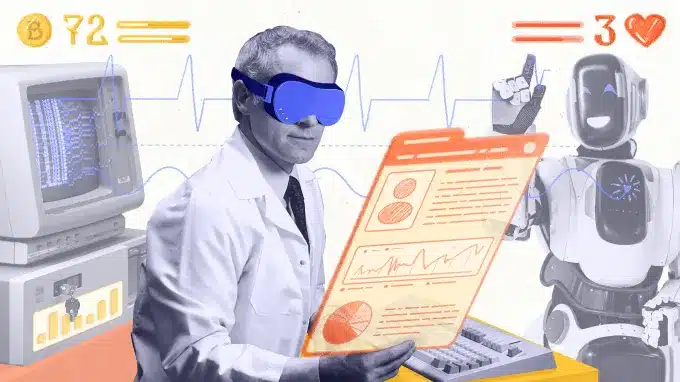Healthcare technology has advanced faster than expected. It is not developing covertly in the background. In plain sight, it is changing every aspect of patient care, including diagnostics. If you are not paying careful attention, you are missing more than just news stories; you are missing the direction that healthcare is taking.
The reality? It still feels like many health systems are catching up. The issues we currently encounter were not intended for legacy tools. You will see a noticeable change as 2025 approaches a realignment from buzz to function, from trends to technology that addresses pressing issues.
Research laboratories no longer evaluate abstract concepts as healthcare technology trends. These days, you may find them in outpatient care applications, on actual hospital floors, and on platforms that support whole clinical ecosystems. The only thing to ask is, are you prepared to change?
Shift from Reactive to Predictive
In the past, healthcare relied on lagging signs. Data has already caused damage by the time it revealed anything. In a high-demand, value-based care setting, such kind of thinking is ineffective.
Predictive analytics drives precision and prevention
These days, healthcare data is more than simply historical. These days, algorithms foresee danger before it materializes. Finally, hospitals are observing:
- Previous measures for patients at high risk
- Reduced hospital readmissions and emergency room visits
- Improved care of chronic illnesses
- The goal here is to completely prevent sickness, not to treat it.
Social determinants of health (SDOH) are finally influencing care
Rather than circumventing the underlying reasons, platforms now incorporate:
- Environmental risk statistics at the ZIP code level
- Food, transportation, and social support accessibility
- Insights from mental health screening
AI Is Reshaping the Daily Clinical Workflow
Ignore the hype. Workflows you utilize regularly are subtly integrating AI. It is not ostentatious. It simply functions.
Ambient Clinical Intelligence is the next quiet revolution
It is screens, not patients, that are burning out clinicians. AI-powered tools currently available:
- Listen in real time to interactions between patients and doctors.
- Automatically record clinical notes
- Provide alternatives for the care plan without interfering with the flow.
Ambient technology is not a substitute for clinical expertise. Clinicians are able to do medically as it eliminates repetitious noise.
Clinical decision support isn’t optional anymore
AI now detects:
- Absence of diagnoses
- Contradictory recommendations
- Inadequate care procedures
Remote Monitoring Is Becoming Standard Protocol
From invention to expectation, RPM has changed.
It’s not just for cardiac patients
More effective methods of managing chronic illnesses, including diabetes, high blood pressure, and even COPD, include:
- Devices that transmit real-time vital signs
- Dashboards with integrated features that notify care teams
- Results of patient reports entered straight from home
These gadgets are not stand-alones. A single Digital Health Platform connects them, completing the cycle from the follow-up visit.
Data Isn’t the Problem Anymore, But Accessing It
Lack of data does not hurt the healthcare industry. System disconnection is a problem. That is rapidly changing.
Interoperability is real, thanks to HL7 and FHIR
Data do not exists in silos now like it used to be. Platforms that use HL7 FHIR protocols include:
- Obtaining patient information from many EHRs
- Standardizing photos and lab findings across systems
- Combining SDOH information with payer claims
Instead of fragmentary notes, this opens the door to whole-person care.
Data visualization is replacing static reporting
These days, dashboards do more than only display metrics:
- Risk rating in real time
- Warning signs of care gaps
- Population-level predictive modeling
Simply gathering data is insufficient. It must speak for you.
Patient-First Interfaces
Patients want healthcare to be as technologically convenient as banking or travel.
Digital front doors are now expected
This implies:
- Online scheduling and rescheduling
- Instant access to visit notes and care summaries
- Messages with care teams are sent asynchronously
You are losing users if your interface still uses paper forms or phone trees.
Virtual care is growing beyond telehealth
Indeed, video visits are becoming commonplace. However, technology is expanding:
- Remote screening for mental health
- App-based post-operative wound monitoring
- Monitoring medication adherence
The focus is on patient-centered treatment.
Precision Medicine Is Scalable Now
We’re moving from population health to precision health.
Genomics and biomarker data inform daily care
Treatment plans are not only centered on a patient’s age or gender. They are:
- Based on risk profiles for genetic diseases
- Matched with the patient’s medicine effectiveness
- Modified in light of additional biomarker information
Smart Hospitals Are Not a Concept, They’re Being Built!
This is not futuristic. It’s happening now.
| Feature | Real-World Use Case |
| Real-time asset tracking | Locate crash carts, wheelchairs in seconds |
| Predictive maintenance | Equipment flagged before breakdown |
| IoT-integrated rooms | Adjust lighting, monitor vitals passively |
Healthcare Workforce Needs More Than Resilience
Workforce analytics reveal stress points
Tools now:
- Keep track of the time spent on each job by the clinician.
- Determine which inefficiencies are wasting hours.
- Make team reallocation suggestions.
Training and upskilling are now digital
Outdated training models are being replaced by AI-guided learning and virtual simulations.
- Feedback in real time when doing virtual operations
- Personalized educational programs for various positions
- Shorter time spent onboarding new employees
Technology Trends 2025 Are Forcing a Rethink in Infrastructure
The most significant changes in healthcare are imperceptible. They are taking place beneath the hood.
Cloud-native platforms
- Real-time updates are released.
- Data storage that scales safely
- Apps rapidly connect with other systems.
The goal is to eliminate friction, not go paperless.
Cybersecurity
Since health systems are frequently the target of ransomware attacks, IT security today consists of:
- Endpoint protection with many layers
- Identification of behavioral anomalies
- Access between departments depends on roles
Protection is not compliance. Being proactive is.
Conclusion
You cannot afford to ignore these trends in healthcare technology as mere business jargon. They have already arrived and are changing your everyday procedures, clinical priorities, and financial outcomes. The gap will quickly expand if your system is still having trouble with legacy integration or restricted visibility.
Persivia provides a uniform framework to facilitate adoption and optimize results to manage this complexity. Persivia’s solutions, which range from predictive analytics to remote care and ambient intelligence, are at the nexus of insight and action, allowing your team to concentrate on providing care that makes a difference.







